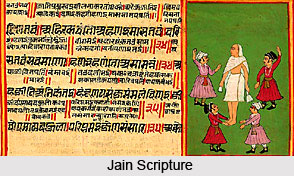 Prakrit is the foremost indigenous phrase of the Indo- Aryan language representing "vernacular". Prakrit emerged, in the 6th century as the literary language, generally patronized by the Kshatriya king in ancient India. The earliest extant model of Prakrit is the Ashokan inscription. The initial form of Prakrit language was Pali, which was the language of the Buddhist, but the Jains best employed Pali. The sacred texts of the Jains (Siddhanta & Agama) employed three types of Prakrit.
Prakrit is the foremost indigenous phrase of the Indo- Aryan language representing "vernacular". Prakrit emerged, in the 6th century as the literary language, generally patronized by the Kshatriya king in ancient India. The earliest extant model of Prakrit is the Ashokan inscription. The initial form of Prakrit language was Pali, which was the language of the Buddhist, but the Jains best employed Pali. The sacred texts of the Jains (Siddhanta & Agama) employed three types of Prakrit.
This primitive form of Indo- Aryan language was categorized into primary & secondary Prakrit. The primary Prakrit encompasses all the languages of the Midland Asia or Aryavarta. It used to follow the strict laws of the phonetics, and had a propensity to shorten the harsh combinations of consonants and broader diphthongs. This primary level of the language was synonymous to the old Italic dialects of Latin times.
The secondary Prakrit under the name of the Pali became popular among the Buddhist and was one of the main instruments for propagating the Jain religion. Wide ranges of independent secular literatures including Indian dramas of the contemporary epoch were written in Prakrit. A further development in the language was observed with the advent of " Apabhramsa" or the " corrupt language". As is pointed out by the grammarians, the emergence of the "Apabhramsas", had a damaging impression on the refined Prakrit.
The language was extended from the east of the Lahore to the entire Region at the confluence of Ganga & Jamuna. Magadhi, Ardhamagadhi & Maharashtri were the languages of the primary Prakrit. Maharashtri attained literary prominence, which became the principal language in lyric poetry and the "kavyas" and at the same time several treatises.
The literatures composed in this language were mainly the Buddhist & Jain Scriptures. The sutras of the Jains were in Ardhamagadhi, the non-canonical books of the Svetambara sect were the form of Maharashtri & the canonical texts of the Digambaras was a variety of Sauraseni. The most admired work, "Sattasai"( Saptasaptika), by Hala composed between the 3rd & 7th century B.C shows the wide application of the Prakrit in the contemporary era . "Kavyas" or the epic poetries like "Ravanavaha" or " Setubandha"(dealing with the subject of Ramayana) & Gaiidavaha of Vakapati ( dealing with the conquest of Bengal by Yasovarmana) etc. were the celebrated works in Prakrit. Reference of Kumarapala-carita , the title of last eight cantos of Dvyasara Mahakavya(1150 A.D) of Hemchandra should also be made. Siddha-hemcandra was an anthology of Prakrit grammar. "Karpuramanjari "(an amusing comedy of intrigue), by Raja Shekhar is a famous exemplar of dramatic literature.
Prakrit dialectic is a significant subject in the contemporary literary tradition. A famous form of Prakrit dialectic was employed in the Sanskrit drama of the period. Different dialectic was used for different purpose, like Sauraseni was used for prose and Maharashtri was the language of the lyric poetry and the songs. Even the characters of the dramatic poetry were attributed with specific dialect according to their nationality. The Prakrit dialect was best used in Mocchakatika.



















